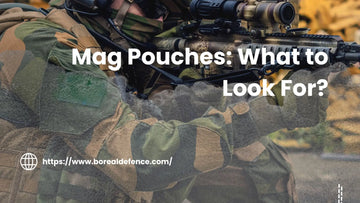How to repair a ripped plate carrier, it’s not just a handy skill; it’s a must if you depend on your gear. Whether you’re out in the field, training, or just running drills at the range, your plate carrier takes a beating. Rips and frays happen. But here’s the good news: you don’t have to toss it every time something tears.
This guide walks you through practical repair techniques to extend the life of your carrier and other nylon gear. Let’s get to it.
Check the Damage First, Not All Rips Are Equal
Before diving into a repair, take a moment to inspect the tear. Is it just surface-level damage? Or is it somewhere important, like near a shoulder strap or MOLLE attachment? Knowing what you’re dealing with saves time and helps avoid a weak fix that won’t hold up under pressure.
If the damage is near a load-bearing area, like the shoulder yoke or where you attach your pouches, you’ll want to reinforce more than just the fabric. If it's a light tear on a non-stress zone, you can usually stitch it up in no time.
And yes, if you’re working on a plate carrier with plates, take those out before you start. You don’t want to risk damaging your armor, or worse, stabbing your finger trying to work around it.
Common Types of Rips & How to Handle Them
|
Rip Location |
Type of Repair Needed |
Tools You’ll Need |
|
Fabric Surface |
Hand stitch or glue |
Nylon thread, needle |
|
Seams (coming apart) |
Machine stitch preferred |
Sewing machine, heavy thread |
|
MOLLE Webbing |
Reinforce with a patch |
Extra webbing, bar tack |
|
Plate Pocket Tear |
Strong reinforced stitch |
Curved needle, nylon thread |
Must-Have Tools to Repair Nylon Tactical Gear
Repairing a tactical plate carrier isn’t complicated, but it does require a few solid tools. These are staples you’ll want in your Nylon Kit, whether you are patching gear at home or fixing it on the go.
- Heavy-duty nylon thread (bonded or waxed is best)
- Curved or upholstery needles – great for tight corners
- Sharp scissors – regular ones won’t cut it
- Seam ripper – for cleaning up old stitching
- Lighter – seals thread ends to prevent fraying
- Fabric glue – like Gear Aid or Seam Grip for fast fixes
- Spare webbing and Velcro – to rebuild damaged sections
Pro tip: If you don’t have a machine that can sew nylon, check with local tailors or cobblers. Some are surprisingly well-equipped for tactical repairs.
You can also read: Plate Carrier Setup Guide
Use The Right Stitching Technique
Let’s be real, this isn’t a fashion piece. Your stitches don’t have to be pretty. They need to hold under pressure, friction, and weather. Especially if you're running a plate carrier setup loaded with mags, comms, and med gear.
The box-X stitch is your best friend for reinforcing straps and webbing. Bar tacks are also great for high-stress points (like MOLLE), and a strong backstitch can work wonders on torn seams.
You can also explore: Military Gear
Stitch Types That Work for Tactical Repairs
- Box-X Stitch: Strong and clean; ideal for straps or anchor points
- Bar Tack: Great for MOLLE webbing and loops(requires a machine)
- Backstitch: Easy to do by hand; surprisingly strong
- Whip Stitch: Good for temporary or emergency repairs
Keep your stitches tight and consistent, but don’t go overboard. Too many passes through the same spot can weaken the fabric.
Reinforce Your Fix—Don’t Just Patch, Fortify
One stitch isn’t enough. Once the basic repair is done, reinforce it. That might mean adding an extra strip of nylon webbing, sewing on a patch, or laying down some fabric glue as a second barrier.
Always seal your threads with a lighter. This prevents fraying and keeps your hard work from unraveling. If you’re repairing a military plate carrier, look at how the original build handles weight, then mimic it.
Patches aren’t just cosmetic. Done right, they’re armor for your armor. Just make sure you’re not adding bulk where you need flexibility.
You can also read: Essential Law Enforcement Gear
Know When to Repair and When to Retire Your Carrier?
Sometimes a fix is a fix. Other times, you’re just delaying the inevitable. Knowing the difference is part of maintaining reliable gear.
Here’s a quick guide:
- Torn seams in load-bearing zones? Might be worth replacing.
- Loose MOLLE? You can usually reinforce it.
- Plate pocket won’t hold plates snugly? Time for a new one.
- Velcro completely shot? Tough to repair, maybe replace.
But if it's just a cosmetic tear or frayed edge? Fix it. Keep your carrier going. Many of the best plate carriers out there still need a little TLC after a few years of use.
There’s pride in keeping your gear battle-ready. Even if it’s a bit rough around the edges.
Don’t Forget to Waterproof After Repairs
Here’s one most people forget: repairs can mess with your gear’s water resistance. Whether you stitched through coated nylon or added a patch, you’ve potentially opened up spots where moisture can seep in.
Use a waterproofing spray (Nikwax, Scotchgard, etc.) on and around your repair. You’ll be glad you did next time you're out in the rain or crawling through muddy terrain.
Also, test your repair before you trust it. Give the area a good pull. If it shifts, frays, or loosens, go back in and reinforce.
You can also explore: Tactical Gear for Outdoor Survival
Want More Gear Tips or Thinking About Upgrading?
If you’ve made it this far, you care about your loadout, and you know a good plate carrier is more than just armor. It’s your mobile base. Whether you’re patching a tear or building your next kit from scratch, understanding how it all works is half the game.
At Boreal Defence, we specialize in gear that’s built tough, tested in the field, and ready when you are. From Chest Rigs to tactical accessories, we’ve got what you need to stay protected and prepared.
Explore Boreal Defence Collection today and upgrade your loadout with confidence.
People Also Ask:
What is a plate carrier?
A plate carrier is a piece of tactical gear designed to hold ballistic plates that protect the wearer from bullets and shrapnel. It’s typically made from durable nylon, features MOLLE webbing for attachments, and is used by military, law enforcement, and civilian tactical users.
What plate carrier does the Army use?
The U.S. Army currently uses the Improved Outer Tactical Vest (IOTV) and the newer Modular Scalable Vest (MSV) as standard issue. Both are considered advanced military plate carriers, offering customizable protection with scalable coverage based on mission requirements.
How should a plate carrier fit?
A plate carrier should fit properly but allow full mobility. The top of the front plate should sit right at the suprasternal notch. The sides should wrap securely without restricting movement or breathing. A poor fit means less protection and more discomfort.
How much does a plate carrier weigh?
That depends on the plate carrier setup and the type of armor plates used. An empty plate carrier may weigh 2 to 4 lbs. With Level IV ceramic plates and gear attached, a full loadout often weighs 18 to 30 lbs, sometimes more, depending on attachments.
How to set up a plate carrier?
Start by inserting your plates securely, then attach mission-critical gear, mag pouches, IFAK , comms, admin pouch, etc. Balance your plate carrier setup to avoid lopsided weight and keep essentials within easy reach. The MOLLE system helps with modular setup flexibility.
How to wear a plate carrier?
Put on your plate carrier like a vest, shoulder straps over your shoulders, cummerbund or side straps around your torso. Adjust the straps until they’re snug but not too tight. Make sure the plates are positioned correctly. Don’t wear it too loose; it should move with you, not on you.
What size plate carrier do I need?
The size of the plate carrier typically matches the size of your armor plates, not your shirt size. Most plates come in 10”x12” or SAPI sizes. Measure your chest and refer to the manufacturer’s sizing chart. A good plate carrier should hold plates without shifting or bouncing.
How to put on a plate carrier?
Undo the cummerbund or side straps, pull the carrier over your head, then secure the straps tightly around your torso. Some models have quick-release systems or side entry; follow your carrier's specific design. Always double-check that the plates are centered and at the right height.
How high should a plate carrier be?
Your front plate should sit just above your sternum, covering vital organs like the heart and lungs. The top of the plate should align with the notch at the base of your throat (the suprasternal notch). Too low and you lose protection; too high and it’ll dig into your throat.
How to wash a plate carrier?
Remove the plates and all gear attachments. Hand wash the nylon carrier in cold water with mild detergent—don’t use bleach or harsh chemicals. Scrub lightly with a brush, rinse, and air dry. Avoid putting it in the washing machine or dryer, as that can damage the material and stitching.







